Protocols for Plant Tissue Culture
Sterilizing Plant Materials
Inside the glove box, sterilize all plant material in diluted domestic bleach solution containing 1 drop of detergent as a surfactant. Put plant pieces in a jar containing the bleach for 10–20 minutes. Agitate frequently. Transfer the tissue in the bleach solution to the sterile area. Discard the chlorine solution. Rinse plant pieces twice with sterile water.
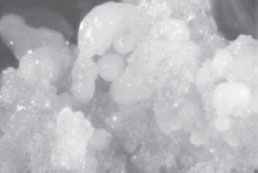 |
| Figure 5 Callus development. |
- Prepare a batch of basic media without added coconut milk or malt extract.
- Follow the sterilization steps for the medium, instruments, and chamber.
- Organize the cultures, sterile media, sterilized tools, and sterile paper towels, and sterile water at one end of the chamber. At the other end of the chamber, organize a small paper bag for trash, a jar of bleach solution,
and a spot for freshily inoculated cultures. The idea is for materials to always move in the same direction. This will help keep you from getting confused. - Sterilize your plant tissue, following this protocol.
- Take a sterilized piece of tissue from the jar with a pair of forceps (do not touch the plant material with your hands). Working on a dampened sterile paper towel, use the scalpel or a razor blade to cut the tissue sample into 2- to 3-cm-long pieces.
- Put 1 piece of the tissue into each container (it is important to have only 1 shoot per container at this stage so that if the shoot is contaminated it cannot spread to the others). Shut the lids of the containers.
- Store jars at room temperature away from direct sunlight. Callus will start to become visible after about 7 days post-initiation.
- Friable type II callus should be separated from more organized callus and/ or watery unorganized callus 2–3 weeks after initiation.
- Friable type II callus should be visually selected at each subsequent transfer to maintain an optimal phenotype.
- Callus should be transferred to fresh medium at 2- to 4-week intervals, depending on growth rate. Switching to different types of media also helps maintain vigor.
- Callus can be maintained at room temperature in the dark.
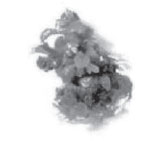 |
| Figure 6 Source. |
- Prepare a batch of media containing 5% to 10% coconut milk.
- Follow the sterilization steps for the medium, instruments, and chamber.
- Organize the cultures, sterile media, sterilized tools, sterile paper towels, and sterile water at one end of the chamber. At the other end of the chamber organize a small paper bag for trash, a jar of bleach solution, and a spot for freshly inoculated cultures. The idea is for materials to always move in the same direction. This will help keep you from getting confused.
- With a pair of forceps, remove a culture from its container. Moisten the sterile paper with some sterile water. It is important to do all the manipulation on a damp paper towel, as these plants are very soft and can desiccate readily.
- Cut stems off the culture and transfer to new jars. At this stage, up to 5 stems may be put inside each jar.
- Store cultures as explained in the previous stage.
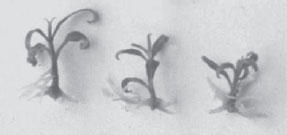 |
| Figure 7 |
Once you have established enough shoots, let them grow to at least 2 cm before beginning the rooting process.
- Prepare a batch of media containing malt extract.
- Follow the sterilization steps for the medium, instruments, and chamber.
- Organize the cultures, sterile media, sterilized tools, sterile paper towels, and sterile water at one end of the chamber. At the other end of the chamber, organize a small paper bag for trash, a jar of bleach solution, and a spot for freshly inoculated cultures. The idea is for materials to always move in the same direction. This will help keep you from getting confused.
- With a pair of forceps, remove a stem from its container. Wash all of the media off the culture and transfer to malt media. (Malt contains auxins, which promote root formation.)
- Up to 5 shoots may be put in each culture vessel. Store containers in their usual place as before. Roots should form within 2 to 4 weeks.
- Fill plastic “vegetable” bags with a potting mix that contains no fertilizer.
- Autoclave for 15 minutes in the pressure cooker.
- When cool, inoculate with mycorrhizae.
- Remove the rooted plants from agar medium using a pair of forceps.
- Wash off the agar thoroughly from the roots using lukewarm water.
- Poke a hole in the middle of the potting mix, using a sterile instrument, gently insert the roots in that hole.
- Dampen the potting mix with basic nutrient mix.
- Spray the foliage with a hand spray containing sterile water.
- Keep these bags inside larger plastic containers with a glass cover, out of direct sunlight. Gradually remove the glass cover, but watch for signs of desiccation and if needed, use the hand spray to spray water on the foliage. Gradually increase the light intensity for the plants also.
- When the roots are well established and the plants are acclimatized (this should take about 4–6 weeks), they can be given fertilizer and be treated like any other plant.
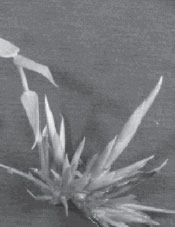 |
| Figure 8 Pseudospikelets growing |
- Prepare a batch of jars with peroxidated media.
- Follow the sterilization steps for the instruments and chamber.
- Organize the cultures, sterile media, sterilized tools, sterile paper towels, and sterile water at one end of the chamber. At the other end of the chamber, organize a small paper bag for trash, a jar of bleach solution, and a spot for freshly inoculated cultures. The idea is for materials to always move in the same direction. This will help keep you from getting confused.
- With a pair of forceps, remove a plantlet from its container. Wash all of
the media off the plantlet and transfer it to peroxidated media. - Watch the cultures carefully for growth of flower buds.
- Collect immature flower buds from plants grown either in the field, the greenhouse, or in vitro.
- Preculture the flower buds in dry test tubes in the refrigerator for 2 days.
- Dip the flower buds in 70% ethanol for 30 seconds, and then surface sterilize with 0.5%–1.0% sodium hypochlorite for 20 min in your glove box.
- Rinse the flower buds with sterile distilled water 3 times, and aseptically excise the anthers and/or ovules using a scalpel and a needle.
- Culture the anthers/ovules on semisolid nutrient medium.
- Incubate the cultures under complete darkness at room temperature.
- Once calli or embryos are initiated, transfer the cultures to daylight.
- Culture the developing embryoids on standard propagation medium.
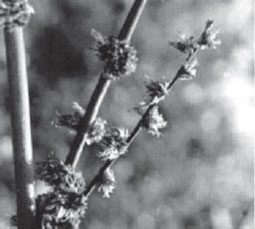 |
| Figure 9 Bamboo inflorescence in vitro |
- Perform all of the following in the glove box.
- Buffer Solution. Dissolve 56.94 g of mannitol in 200 mL of distilled water. Add distilled water to bring the final volume to 500 mL.
- Digestion Solution. Measure 10 mL of buffer solution into a 15-mL test tube or small beaker. Measure 0.1 g pectinase and 0.2 g cellulace onto weighing paper. Drop the premeasured, powdered enzymes into this solution. Swirl the beaker or cap the test tube and shake it back and forth until the enzymes are completely dissolved.
- Carefully pour all 10 mL of enzyme solution into the bottom of a sterile jar.
- Use forceps to float each tissue sample on the surface of the enzyme solution.
- Seal the jar with Saran Wrap or tape and leave it at room temperature (approximately 25°C) overnight. If proper equipment is available, gentle agitation of the dishes will be helpful.
- The next day, gently swirl and shake the solution in the petri dish. (If no protoplasts are observed with the microscope, let the solution stand for another 15–30 minutes, then look again for protoplasts.)
- At the end of the digestion period, gently shake the petri dish to release the protoplasts.
- Filter the enzyme-protoplast suspension through successively smaller filters, starting with the 100-mm sieve. One sieve will trap mostly protoplasts.
- Mix 2 droplets of protoplasts from 2 genetically different strains, along with a droplet of PEG (polyethylene glycol) in a test tube.
- Flood the protoplasts with baking soda dissolved in basic growing mix.
- After 20 minutes, wash with basic growing mix and centrifuge in the salad spinner centrifuge.
- Transfer the fused protoplasts onto callus culture medium.
- Place 2 droplets of protoplasts from 2 genetically different strains, between 2 electrodes.
- Apply 10 volts per millimeter of electrode separation for 1 minute.
- Apply a 10- to 20-msec pulse at 100 volts per millimeter. This will require building an electrical pulse apparatus. A 555 timer discharging through an automotive coil might do the trick.
- Wash with basic growing mix and centrifuge in the salad spinner centrifuge.
- Transfer the fused protoplasts onto callus culture medium.
- Prepare a batch of media containing 0.001% to 0.01% trifluralin (Preen or
Treflan brand name). - Follow the sterilization steps for the medium, instruments, and chamber.
- Organize the cultures, sterile media, sterilized tools, sterile paper towels, sterile water, and bleach solution in the glove box.
- Place a clean culture or fused protoplast on trifluralin media.
- Store containers in a cool, dark location. Within 2 to 4 weeks, polyploid shoots should begin developing.
The purpose of agar in growth media is solely to support the tissue. Instead of agar, use sand to support the culture.
- Boil sand in water on your stovetop.
- Store the clean sand in a plastic bag.
- Put ½ inch of sand in a baby food jar.
- Sterilize jars in your pressure cooker.
- Place sterilized jars, prepared caps, and sterile media solution in your glove box.
- In the glove box, add enough sterile media solution to just saturate, but not cover, the sand.
- Close the jar with a prepared cap. Note:Do not microwave the sand, it will splatter all over. When transfering cultures, make sure they are in good contact with the sand but not “swimming” in the media.




